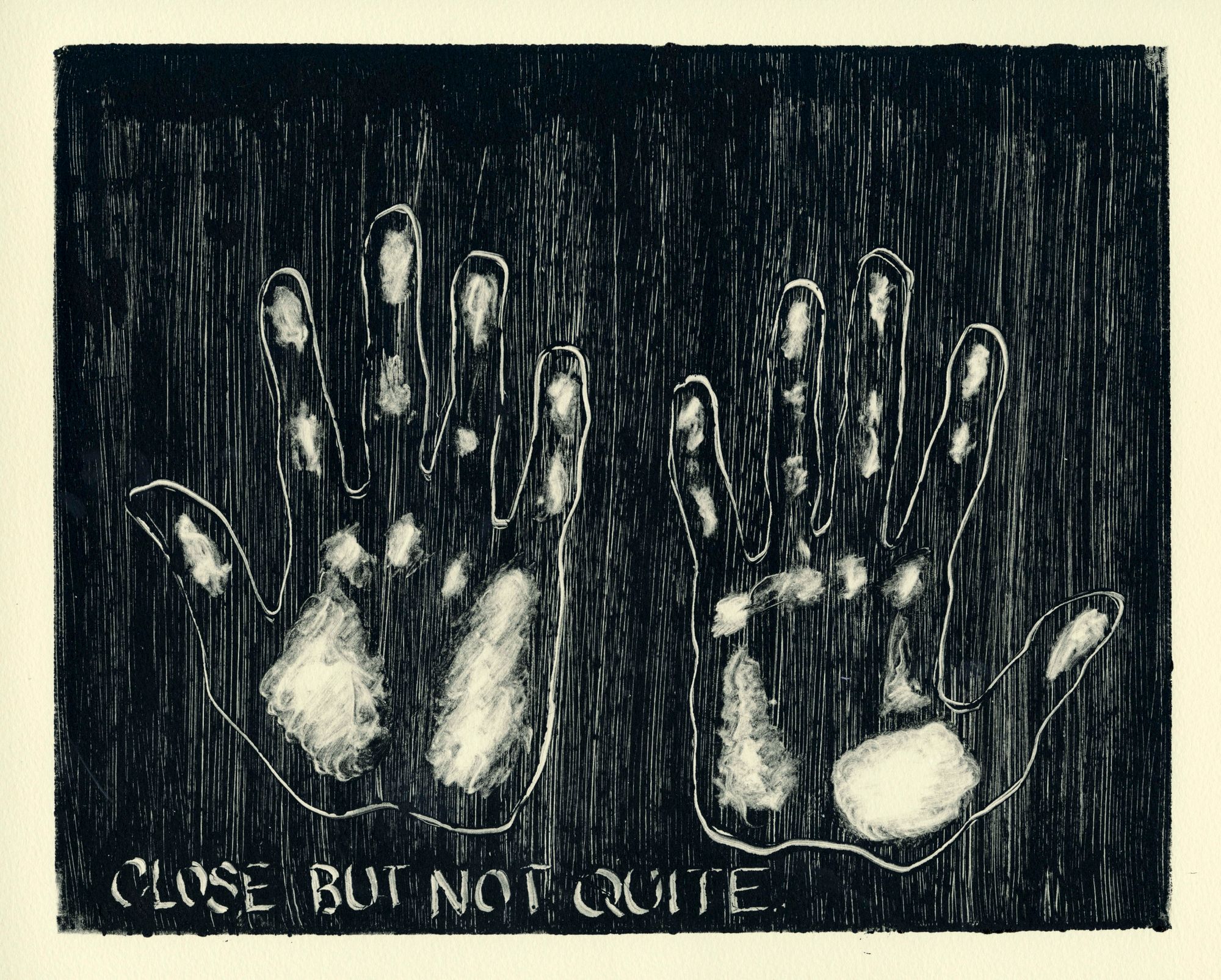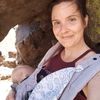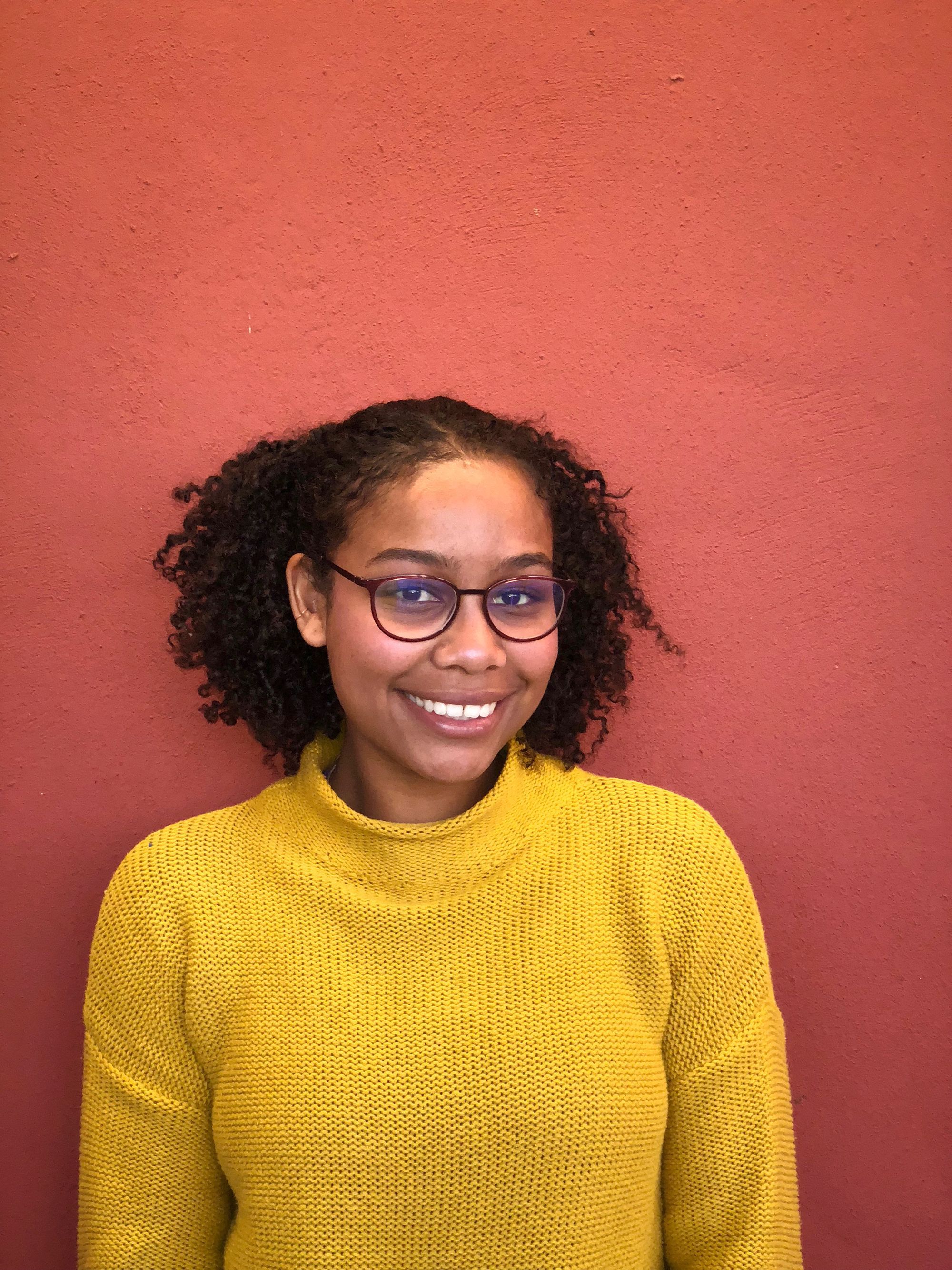Tell us about yourself
I’m a Crucian native and current free floater with experience in branding, motion graphics, printmaking, painting, and product prototyping. My artwork and personal designs center around identity, wellness, and process. I aim to merge my interests of the environment and self-reflection with one another, as our relationship to our external surroundings is so important to shaping who we are in those moments. Ultimately, this becomes apparent in my personal process of creation, playing with juxtapositions — like making fluid shapes out of hard materials, repurposing materials, and finding ways to merge holistic physical activities with/on digital platforms (considering that’s where most people are these days, anyhow).
While I am most excited about the end results of a project, I find that the most personally gratifying part is the process — dealing with frustrations and accepting imperfections. It helps to make work that’s still beautiful, and above all, human. Regardless of where I’m at, you can catch me riding my bike through the city, laying out in the sun, or jotting down ideas in my notes.
Can you tell us a bit about your artistic philosophy?
In my opinion, the more you try, the more you’re exposed to, the more you can see the web of relationships between opposing subjects and ideas. Which leads to truly dynamic perspectives and creations. I’m a big fan of the saying, “A jack-of-all-trades is a master of none, but oftentimes better than a master of one.” Granted, that only works for certain things. I would definitely like my accountant or surgeon to be a master of their field.
Did you always know art would be an integral part of your life?
I always wanted it to be! There were times when I wasn’t sure how, but I knew it was something life felt boring without. At one point, it was joining plays, then sculpting, painting, designing, printmaking, even weaving. I don’t care what I create (in terms of medium), but I need that feeling of making something from nothing.
Tell me a little bit about your connection to the Tri-Cities
Honestly, the only thing I knew about Washington was in regards to Seattle. That was, until my family moved here in 2015. I was a senior in high school, and I stayed in St. Croix, where we’re originally from, to finish up the year. During the holidays and summer breaks, I joined my family in the Tri-Cities and explored the vastly different environment surrounding us. This was the first place I’ve ever seen snow, had a ‘white Christmas’, gone on serious hikes through mountains and national forests, and felt 100+ degree weather. It’s crazy how versatile the landscapes are here. It makes adventuring and road-tripping worth it.

Tell us a little about what you are currently working on
I’ve been getting back into painting, as it’s been a rough couple of years trying to be serious about it since my mentor passed. She taught me how to use oils, which is my favorite painting medium. Most of my more recent paintings are small landscapes and close-ups of the body. My printmaking has been focused still on fluid body shapes, from which I hope to continue making patterns on larger wood panels! I just need A LOT more sandpaper....
As far as design goes, I’ve been doing lots of logo work for various restaurants and entrepreneurs.
Can you tell us a little bit about your technique?
I approach a project by trying to inspire a feeling. Whether that entails creating a moodboard for client work or just trying to sift through emotions of my own, I need to feel compelled to put something down. There’s nothing more daunting than a blank page, canvas, or mind. So after I go through the five stages of grief, contemplating whether my idea/feeling is even worth sharing, I start sketching. Once I get a rough concept of what I think I want down, I continue jumping right into the creation process, as that’s where the gold really lies. Halfway through a painting or carving, I realize what I actually want and am loose enough to start feeling everything out. The second hardest part about starting something is knowing when to stop, and when it’s finished. Printmaking is really nice in that way because you can make as many prints as you want through the process and adjust accordingly. It’s like watching a baby grow up! Painting is a bit more stressful, so I decided that when I start getting annoyed and overly critical of myself, the painting is done.
I love your description of the process of getting started on a piece and how daunting the blank page can be. Do you have regular scheduled time to create? Or do you create when you have a project or when inspiration hits?
I should probably have a better practice when it comes to creating, but unfortunately, I don’t yet. Usually, it comes from a place of longing and dissatisfaction with the day-to-day work that I’ve been doing. Or I’ll see a cool project in a museum or online and be like, I want to try that!
I try to carve out some time on weekends to knock as much out as I can because it’s really hard for me to stop and pick something up later with the same groove. I’ve found that if I make it a point to invite a creative friend over, we both get work done and have more fun doing it!
Do you have a particular routine to get in the zone for creating, like certain music you listen to?
I like to move... a lot! Whether it’s cranking out a few squats, pilates moves, stretching, or dancing, I move as I make. I like to think it keeps the mind flexible so I don’t get hung up on one thing. Music is always a plus (when you have a solid playlist)! But sometimes interesting things happen in silence, too.
Who are your favorite artists?
Oh, what a hard question. I feel like I could name a few but it’ll never be enough. I love Joan Miro, Alberto Giacometti, Henri Matisse, Kara Walker, and Olga de Amaral. All very different types of artists, but still so good at doing their own unique thing. Aspirational.
What inspires you?
Imperfection in nature! The patterns that are found throughout nature are so harmonized and balanced, yet still never completely identical. For one, I just think it’s really interesting how plants, trees, and animals just sort of know how to do their thing. And secondly, they’re unapologetic in their appearance and their flexibility to conform to what their surroundings need at the moment. It’s like the most ideal relationship I can think of, where individuality and reliance/partnership (that juxtaposition) are perfectly equal.
Have you ever viewed a piece of artwork that profoundly shifted your perspective of something?
Well, I’ve always enjoyed Kara Walker’s artwork since I learned about her in high school. But seeing one of those installations in person? Phew. I finally did this past year in the Museum of Fine Arts in Houston, and let me tell you, I bawled right then and there. Not only is the subject matter heavy, but she gets your mind going with those silhouettes. She doesn't show any personal features, and yet I can imagine every single detail. It reminds me how impactful and bold composition and shape can be.
How do you think art effects change?
By making us feel! Art evokes feelings and feelings motivate us toward actions. It sounds simple but, I think we're all more driven by feelings (good and bad, love and fear) than we’d like to admit. And on that note, I hope the art that is created is for good.

How have personal challenges impacted your work?
Self-reflection and identification are continuous themes in one’s life while growing up. And really, this then leads to the question of what/who we use as foundations for how we see ourselves and who we want to be. My personal challenges usually center around my individuality — how to use my voice and even what I want to say with it. My community (family and friends) is huge, and their personalities are even larger. So from an outside perspective, I enjoy watching relationships to one another and myself, as well as how the dynamic can be altered by who we choose to be in those moments.
I love how you describe creating art as this process of self-exploration, and an exploration of relationships. How do you think the viewer plays into this equation? What do you hope the viewer takes from your work?
Oh man, that’s tough. It’s always something I fear because I have no idea what my ‘work’ actually says about me. But maybe figuring it out for myself is kind of the point or quest. And maybe that’s what I’d like the viewer to think about for themselves, as well. Hopefully, there’s a moment when viewers are less concerned about what they think I’m trying to share and instead focus on how it makes them feel, and be okay with not knowing either answer.
What would you tell an artist who is just starting out?
Don’t get caught up in trying to figure out your style, voice, or message. Just allow yourself to enjoy the process of creating rather than focusing on the creation itself. The hardest part about making is the beginning and end, but the most rewarding is during.
How can the community better support artists?
Well, I think the AACCES art show was a great support to the local artists in the Tri-Cities area. Being vocal about the various avenues for artists within communities could help to broaden others’ ideas, both on what it means to be an artist and how one could apply those skills in other fields. We need just as many artists as we do doctors and lawyers, and bonus points if they’re both (:

You have a piece in the AACCES Art Show. Can you tell me a little about that work?
Yes, the woodblock print ‘Confinement’ is a playful experiment of the relationship between fluid shapes in a confined space. It was created with the question of what it means to be an individual in a community, capitalistic society, and even within the structures of our bodies. The print itself resembles this strict, invisible barrier fulfilled by vessels that are mixing and melding into the space, while the woodblock is a literal representation of the hard, constricting boundaries that we try to remain flexible and soft within. Ultimately my goal for the piece (and my personal development) was to create something seemingly smooth out of such rigid material.
Ashleigh Rogers is the Creative Director at DrewBoy Creative. She is an artist and art instructor living in Richland, Washington with her husband and four children.
Find her on Facebook: fb.com/AshleighRogersArt or Instagram: ashleigh.a.rogers


